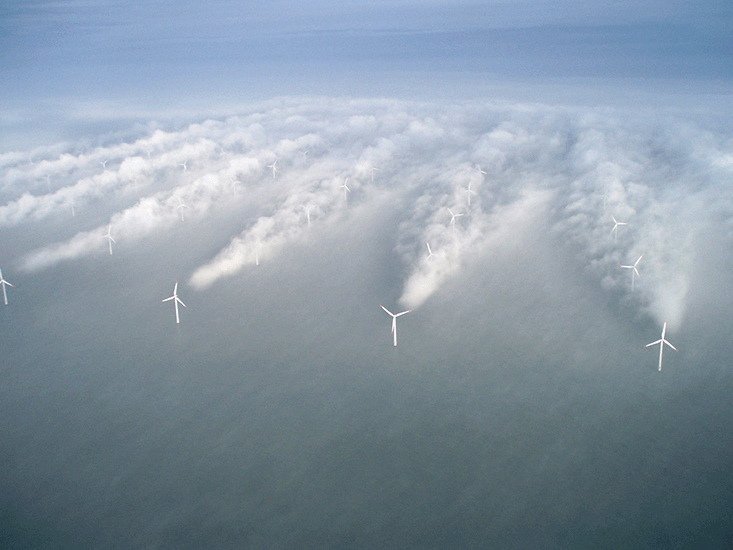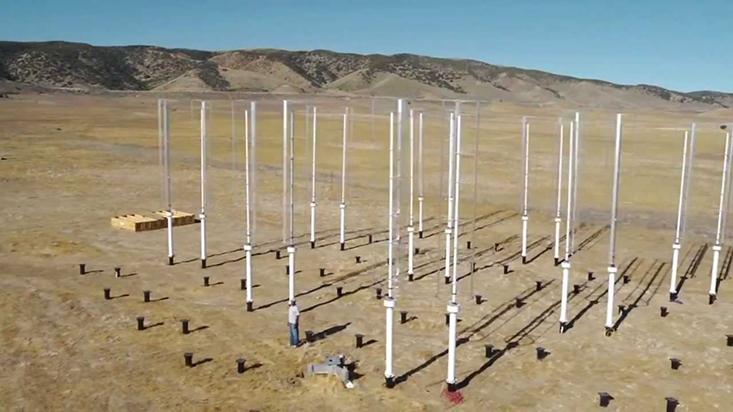As they drove on featureless dirt roads on the first Tuesday of 2010, John Dabiri, professor of aeronautics and bioengineering at the California Institute of Technology, and his then-student Robert Whittlesey, were inspecting a remote area of land that they hoped to purchase to test new concepts in wind power. They named their site FLOWE for Field Laboratory for Optimized Wind Energy. Situated between gentle knolls covered in sere vegetation, the four-acre parcel in Antelope Valley, California, was once destined to become a mall, but those plans fell through. The land was cheap. And, more importantly, it was windy.
Estimated at 250 trillion Watts, the amount of wind on Earth has the potential to provide more than 20 times our current global energy consumption. Yet, only four countries—Spain, Portugal, Ireland, and Denmark—generate more than 10 percent of their electricity this way. The United States, one of the largest, wealthiest, and windiest of countries, comes in at about 4 percent. There are reasons for that. Wind farm expansion brings with it huge engineering costs, unsightly countryside, loud noises, disruption to military radar, and death of wildlife. Recent estimates blamed turbines for killing 600,000 bats1 and up to 440,000 birds2 a year. On June 19, 2014, the American Bird Conservancy filed a lawsuit3 against the federal government asking it to curtail the impact of wind farms on the dwindling eagle populations.4 And while standalone horizontal-axis turbines harvest wind energy well, in a group they’re highly profligate. As their propeller-like blades spin, the turbines facing into the wind disrupt free-flowing air, creating a wake of slow-moving, infertile air behind them.

This problem of aerodynamic interference can be observed in offshore wind farms with tails of condensing, turbulent air trailing the vanguard turbines like a veil caught in the wind; a veil that chokes the turbines it reaches. “Because a wind turbine’s whole job is to extract energy from the wind, this slower wind ends up with less available energy to extract and produce power,” Whittlesey explains. The horizontal-axis turbines’ sheer size—over 100 meters tall in some cases—dictates that they need to be spaced far away from each other, leaving huge gaps where no wind is farmed at all. It’s akin to planting an orchard with apple trees spaced more than 40 meters from one another.
To solve this problem, many researchers looked to nature’s flora and fauna. Some turbine blades have been designed as simulacrums of the lumpy fins of humpback whales, others spin in a figure eight motion akin to a bumblebee’s wing beats.
Dabiri and his colleagues tried a different idea—they used smaller, simpler, and cheaper vertical-axis wind turbines whose positions were inspired by fish in underwater schools.
As an undergraduate, Dabiri modeled the undulating movements of jellyfish. A decade later, he was involved in the construction of a medusoid—a synthetic jellyfish made from elastic silicone and the heart cells of a rat—that swims just like a living jelly when a pulsating electric field is applied.5 During that time, Dabiri also became fascinated with another unorthodox combination: schooling fish and wind power.
Forming large synchronized groups has its advantages for fish, including predator avoidance, enhanced foraging success, and access to mates. It also creates a large amount of turbulent water. As a fish flaps its tail from side to side, it creates a wake of circulating vortices through which its followers have to swim. But by arranging themselves in such a way that each trailing fish swims behind and in-between its two conspecifics in front, fish in a school use these swirling currents to push themselves forward. “The way that [these vortices] turn actually reduces the amount of energy that fish have to put into moving themselves,” Whittlesey said. It’s like a series of underwater wheels beside each fish that supplement their own propulsion.6

These patterns got Dabiri and Whittlesey thinking: If fish can benefit from the vortices produced by their neighbours, could their vertical-axis wind turbines do the same? To estimate the amount of power these bio-inspired arrays could produce, they used computer models. “What we did was put the vertical-axis wind turbines at the same location [and rotation] that we would see vortices being shed from a fish as they swim,” Whittlesey said. But in this pattern, their turbines showed no increase in productivity compared to standalone turbines. Whittlesey said they weren’t too surprised. “Fish are focused on saving energy using the wakes of others, not maximizing power production.” So they moved the wind turbines outside of the strict arrangements of schooling fish, but kept the paired turbines spinning in opposite directions—think upturned electric eggbeaters—and the resulting computer model looked promising. They decided to test their counter-rotating, doublet configurations at their FLOWE site.
Using an array of 18 turbines arranged in a variety of different configurations, they amassed thousands of hours of data. They found that the eggbeater pairs arrangement was indeed the most productive, being able to generate 20-30 Watts of electricity per square meter of land. That’s a tenfold increase over some of the most productive modern wind farms.7 “It’s one thing to get a few percentage points increase,” says Whittlesey. “But we’re talking order of magnitude—that’s substantial.”

Dabiri and Whittlesey don’t know exactly why turbines packed into closely positioned pairs are the most efficient, but they have a couple of working theories. The first is that in this doublet configuration the flow of air generated by one spinning turbine boosts the speed of its partner, and vice versa. “They are kind of like gears; you can imagine that by one spinning clockwise and the other spinning anticlockwise they could mutually benefit each other,” Whittlesey says. The second theory is that the wake of slow wind behind these turbines is greatly reduced. “The wake is not as persistent as we’d get with the horizontal-axis wind turbines.”
Consequently, free-flowing air is more readily available in these systems, which allows the turbine pairs to be packed more closely together—only four diameters apart compared to a norm of 15 diameters for horizontal-axis wind turbines. With less space used, these intimate arrays harness a greater proportion of the wind flowing through.
The team is also testing two vertical-axis wind turbines in the rural village of Igiugig, Alaska. Funded by the Gordon and Betty Moore Foundation, this nascent project aims to install from 50 to 70 small, visually inconspicuous turbines to power the entire village. Right now, the 50 or so inhabitants of this remote region in Alaska’s Bristol Bay are entirely dependent on the costly and laborious transportation of diesel for their electricity generators. “That makes wind [power] really attractive because there’s just the capital costs and maintenance,” Whittlesey said, “but at least the fuel is free.”

Dabiri and his colleagues are also looking to optimize their arrays further by turning to another denizen of the oceans: seagrass. Beds of seagrass use a vertical circulation of water to transport oxygen and nutrients into their tissues. Their stalks of varying heights are thought to augment this circulation. So the team will be using turbines of different heights to investigate how they can better harness the wind coming from above the farm canopy.
Using these test sites as stepping-stones, the bioengineers hope, not just to make wind power more economically viable, but to solve some of the drawbacks that has brought wind power under scrutiny. Because of their small size, the vertical-axis turbines require less building material, are quieter, and don’t interfere with radar signals. Perhaps more importantly, they don’t require large swathes of land, and won’t interfere with endangered bird species such as bald and golden eagles. “When a vertical-axis wind turbine is spinning it looks like a solid object, making it easier for wildlife to avoid them,” Whittlesey explains. “As far as I’m aware, there’s never been a bird or bat death associated with these turbines… And here in California, we love our birds.”
Alex Riley has a Master’s in zoology and writes about a variety of topics from the natural world on his blog, Bacteria to Bonobos. He tweets at @riley__alex.
References
1. Hayes, M.A. Bats killed in large numbers at United States wind energy facilities. BioScience 63, 975-979 (2013).
2. Wind energy frequently asked questions. American Bird Conservancy www.abcbirds.org.
3. Deborah Shearwater, Steven A. Thal, Michael Dee, Dr. Carolyn Ctockett, Robert M. Ferris, and American Bird Conservancy v. Dan Ashe, Director, United States Fish and Wildlife Service; Sally Jewell, Secretary, United States Department of the Interior, Case No. 5:14-cv-02830 (2014).
4. Johns, R. American Bird Conservancy sues feds over 30-year eagle kill rule. American Bird Conservancy www.abcbirds.org (2014).
5. Nawroth, J.C., et al. A tissue-engineered jellyfish with biomimetic propulsion. Nature Biotechnology 30, 792-797 (2012).
6. Whittlesey, R.W., Liska, S., & Dabiri, J.O. Fish schooling as a basis for vertical axis wind turbine farm design. Bioinspirations & Biomimetics 5 (2010). Retrieved from doi:10.1088/1748-3182/5/3/035005.
7. Dabiri, J.O. Potential order-of-magnitude enhancement of wind farm power density via counter-rotating vertical-axis wind turbines arrays. Journal of Renewable and Sustainable Energy 3 (2011). Retrieved from doi:10.1063/1.3608170.






























